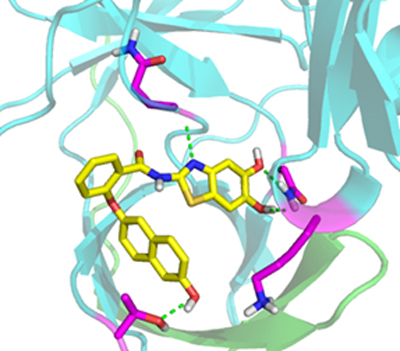Better substances for treating the dengue virus

The interactions of the protease inhibitor (yellow) with the enzyme were analyzed using computer-assisted methods. Image: Hongmei Wu
In the quest for medication to treat the dengue virus, the scientific community is focusing on a particular enzyme of the pathogen, the protease known as NS2B/NS3. The reason for this is that inhibitors of similar proteases have been revealed to be very effective with other viruses. Protease inhibitors are already being used successfully in the treatment of HIV and Hepatitis patients.
There are also several inhibitors for the dengue protease. However, at best, they stop only half of the viruses from multiplying, which is not enough for clinical applications. The Würzburg team led by virologist Jochen Bodem, in collaboration with scientists from the University of Mainz, has discovered far better inhibitors, which are now presented in the journal “Antimicrobial Agents and Chemotherapy”.
“We have developed seven good to very good inhibitors from the diaryl thioether class of molecules, and two of these are even really good,” says Bodem. When these two “stars” are used, only around three percent of the virus population in a cell culture survives even with very low concentrations of the active substance. From the point of view of science, this is a very good result, especially as the inhibitors, as desired, are highly specialist: they only target dengue viruses and have no impact whatsoever on very close relatives like the Hepatitis C virus.
The leading members of the team of researchers
The new active substances were developed by a team of virologists and pharmacists. From Mainz, Professor Tanja Schirmeister and, in particular, her colleague Hongmei Wu, were involved. Both conducted research at the University of Würzburg until a few years ago. Schirmeister’s team synthesized the inhibitors and then examined and further developed their interactions with the enzyme using computer-assisted methods.
On Jochen Bodem’s team, Stefanie Bock, who is now working towards a doctorate at the University of Münster, played a key role. Here the protease of the viruses was obtained and cleaned. The effect of the active substances on the dengue virus was later demonstrated in the safety laboratory. As a next step, the scientists will check whether the new active substances have negative effects on higher organisms and whether they inhibit viral replication there as well.
Dengue fever is spreading worldwide
Dengue fever originated in the tropics. However, for a few years now it has also been found in other warm regions of the world, such as the Mediterranean. Scientists are attributing this to climate change: the mosquitoes that transmit the virus to humans are able to expand their habitat thanks to increasing global warming.
The Robert Koch Institute reported on dengue fever in southern France and Croatia back in 2010. In Germany in 2013, there were a total of 879 recorded dengue patients – all travelers who had become infected in the southern hemisphere and in tropical countries. The World Health Organization estimates that the number of infections globally stands at 390 million a year. In 1970, infections occurred in just nine countries; these days, that figure has already risen to over 100.
Infection varies from asymptomatic to life-threatening
The virus is transmitted by the tiger mosquito and other mosquitoes. Usually the infection goes unnoticed since there are no signs of the disease in almost 90 percent of cases. In the remaining cases, an influenza-type illness develops, which may take a potentially fatal course, especially in children: in addition to muscle and bone pain accompanied by a high temperature for days, the patient then develops internal bleeding and other severe symptoms. Without intensive medical treatment, around half of these sufferers die.
To date, there is no vaccine and no way of fighting the dengue virus with specific drugs. It is therefore recommended that measures be taken to protect against mosquito bites in countries where there is a risk of infection; these include covering the skin with clothes as much as possible, sleeping under a mosquito net and applying mosquito-repellent creams.
“Novel Dengue virus NS2B/NS3 protease inhibitors”, Hongmei Wu, Stefanie Bock, Mariya Snitko, Thilo Berger, Thomas Weidner, Steven Holloway, Manuel Kanitz, Wibke E. Diederich, Holger Steuber, Christof Walter, Daniela Hofmann, Benedikt Weißbrich, Ralf Spannaus, Eliana G. Acosta, Ralf Bartenschlager, Bernd Engels, Tanja Schirmeister, and Jochen Bodem, Antimicrobial Agents and Chemotherapy, published online, December 8, 2014, doi:10.1128/AAC.03543-14
Contact
Dr. Jochen Bodem, Institute of Virology and Immunobiology at the University of Würzburg, T +49 (0)931 31-81509, jochen.bodem@vim.uni-wuerzburg.de
Prof. Dr. Tanja Schirmeister, Institute of Pharmacy and Biochemistry, University of Mainz, T +49 (0)6131 39-25742, schirmei@uni-mainz.de
Media Contact
More Information:
http://www.uni-wuerzburg.deAll latest news from the category: Life Sciences and Chemistry
Articles and reports from the Life Sciences and chemistry area deal with applied and basic research into modern biology, chemistry and human medicine.
Valuable information can be found on a range of life sciences fields including bacteriology, biochemistry, bionics, bioinformatics, biophysics, biotechnology, genetics, geobotany, human biology, marine biology, microbiology, molecular biology, cellular biology, zoology, bioinorganic chemistry, microchemistry and environmental chemistry.
Newest articles

Silicon Carbide Innovation Alliance to drive industrial-scale semiconductor work
Known for its ability to withstand extreme environments and high voltages, silicon carbide (SiC) is a semiconducting material made up of silicon and carbon atoms arranged into crystals that is…

New SPECT/CT technique shows impressive biomarker identification
…offers increased access for prostate cancer patients. A novel SPECT/CT acquisition method can accurately detect radiopharmaceutical biodistribution in a convenient manner for prostate cancer patients, opening the door for more…

How 3D printers can give robots a soft touch
Soft skin coverings and touch sensors have emerged as a promising feature for robots that are both safer and more intuitive for human interaction, but they are expensive and difficult…





















